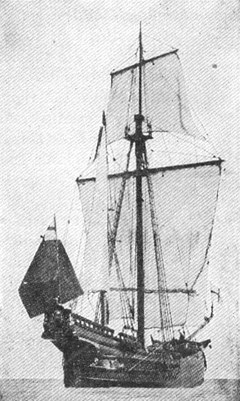For 200 years, ships sailed to England from Hudson Bay with huge cargoes of furs. Sale of these furs was very lucrative for the shareholders of the Hudson’s Bay Company. — French adventurers, Radisson and Groseilliers had found their way to London and convinced King Charles II, his cousin Prince Rupert and a group of merchants to invest in an expedition to a northern part of Canada — Hudson Bay. In 1668 two vessels were outfitted for the trade — the EAGLET, with Radisson on board and the NONSUCH under Groseilliers. The EAGLET developed a mechanical problem and was forced to return to England, but Groseilliers continued his course. He entered the Bay and sailed further south to James Bay where he built Fort Charles. News spread and traders from various tribes of the area flocked to the fort with their furs. Months later, Groseilliers returned to England with an exceedingly valuable cargo. This of course, impressed the investors, resulting in a charter being signed by the King of England that established the rights for the Hudson’s Bay Company to trade on lands that now comprise what is now western Canada. Hundreds of fur trading forts would be erected. The First Nations people were not consulted about this grand plan that changed their lives dramatically. Even English governments over the centuries questioned the legality and terms of this charter. It also ignited more conflict between France and England, culminating in the war of 1759 and the Treaty of Paris in 1763, by which the French Colony of Canada became a British Colony. The stories of centuries past are told to show that today we still have direct links with the events following the 1867 Confederation that affected western Canadian settlement. A major event was the 1869 Deed of Surrender of western lands by the Hudson’s Bay Company to England, and soon transferred to the new Dominion of Canada, whose government began enacting legislation to open up the West for settlement. Still the Hudson Bay Company survived as a mercantile business — hardware and canned foods, closing many fur forts, but leaving many in operation to provide some fur trading with First Nations and Métis people still involved in trapping. Three main forts left open in our part of these western territories were: Fort Pelly, Fort Ellice and Fort Qu’Appelle. Incoming settlers such as the York Colony settlers from Ontario and the British Isles, starting in 1882 shopped for supplies at these old forts. Then, the HBC started erecting new palatial-looking stores in more prominent large centres. However, they opened up a store in Yorkton in 1898, in spite of it having only village status at the time. In 1912, the construction of the elaborate building on Broadway Street and Second Avenue and still standing today, was a huge testimony to the confidence the Company had for extensive trade in the town of Yorkton and the region.
Source of image: History of Canada for High Schools 1944.
Contact Terri Lefebvre Prince,
Heritage Researcher,
City of Yorkton Archives,
Box 400, 37 Third Avenue North
Yorkton, Sask. S3N 2W3
306-786-1722
[email protected]




